Module 2—Motion in Two Dimensions
Predicting a Projectile's Motion
initial velocity: the velocity of an object when an experiment begins
The displacement and velocity of a projectile at any time during its flight may be determined in advance. All you would need to know are the initial velocity and initial position of the projectile.
The next example shows how you can use just the initial velocity and initial position to calculate the displacement and velocity a projectile will have at some later time.
Suppose a ball positioned at (x, y) = (20.0 m, 10.0 m) has an initial velocity of 20.0 m/s at an angle (θ) of 60.0° relative to the positive x-axis. That is, (vi, θ) = (20.0 m/s, 60.0°).
What is the ball’s velocity when t = 2.50 s, and what will the ball's displacement be during this time interval?
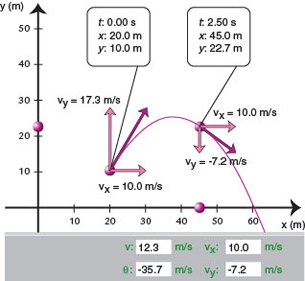
Figure 1
Remember that the horizontal and vertical components of projectile motion are independent of each other. The equations for the x components do not contain any y components, and vice versa. This simplifies the mathematical aspects of projectile motion a great deal. Instead of a complicated two-dimensional problem, you are dealing with two separate one-dimensional problems.
The kinematic equations for motion with constant acceleration that you studied in Module 1 will be required to calculate both the velocity and displacement.
Those equations are given in terms of x and y components (one-dimensional). The initial position is already in this form, but the initial velocity is in polar form and needs to be converted to component form, effectively separating the x and y components of the given velocity.
These are the calculations:
- horizontal component of the initial velocity

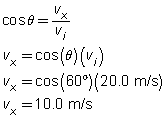
-
vertical component of the initial velocity

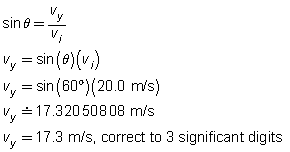
Note that these values are shown in the data panel before the simulation is played.
Calculating Velocity
Substitution of the initial velocity components and the time (t = 2.50 s) into the acceleration equation gives the final velocity of the x and y components at the time specified in the question.
- horizontal component of velocity at t = 2.50 s
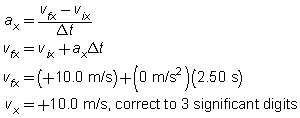
- vertical component of velocity at t = 2.50 s
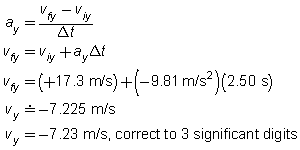
Calculating Displacement
Substitution of the initial velocity components and the acceleration components into the equation for displacement when t = 2.50 s gives
- horizontal component of displacement when t = 2.50 s

The horizontal displacement is 25.0 m. Given the initial horizontal position of 20.0 m, the horizontal position after 2.50 s will be 20.0 m + 25.0 m = 45.0 m
This agrees with the position displayed in Figure 1.
- vertical component of displacement when t= 2.50 s

The vertical displacement is +12.6 m. Given the initial vertical position of 10 m, the vertical position after 2.5 s will be 10 m + 12.6 m = 22.6 m.
This is very close to the position displayed in Figure 1. You could expect some difference because you used 9.81 m/s2 for the magnitude of the acceleration while the simulation uses 9.8 m/s2.